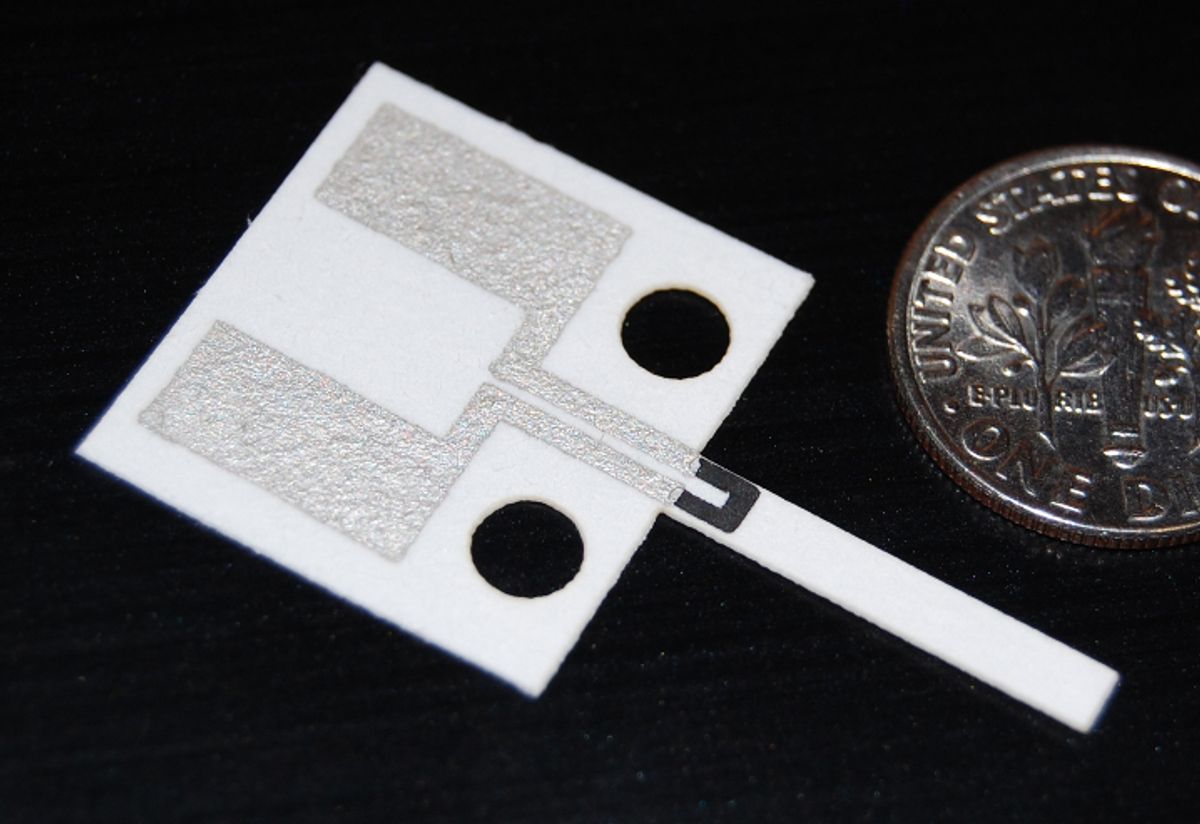Tiny microscale accelerometers revolutionized car air-bag deployment systems in the mid-1990s. Costing a few dollars apiece and just a few millimeters wide, these sensitive microelectromechanical systems (MEMS) devices carved from silicon replaced a bulky, multicomponent deployment system that used to cost more than US $50.
Now researchers at Harvard have fashioned a MEMS force sensor that's so cheap it could be disposable. It's made from paper, and each one costs four cents. The team presented the design and experimental results of the device at the IEEE MEMS 2011 conference last week.
The new device emulates the piezoresistive silicon MEMS sensors that are at the heart of many modern accelerometers. Piezoresistance is the change in resistivity when a material is under mechanical stress. Aside from air-bag deployment, MEMS accelerometers are used to monitor vibrations in buildings and bridges, to trigger hard-disk protection in falling laptops, and to sense motion in iPhones and Wii remotes.
Harvard chemistry professor and paper device pioneer George Whitesides, who led the new work, says he does not expect the paper sensors to replace silicon accelerometers. He doesn't currently have specific applications in mind, but he expects the low-cost, lightweight, and easy-to-fabricate devices to open up new applications in different areas, from consumer gadgets to medicine.
“MEMS is a wonderful technology for a number of things—digital mirrors, air bags, the safety mechanism for nuclear weapons—but you don't find such devices in every part of the kitchen, and partially the reason is it's too expensive," Whitesides says.
Paper-based MEMS force sensors are appealing because of their low cost, says Kevin Dowling, vice president for research and development at mc10, a flexible-electronics start-up in Cambridge, Mass. What is truly exciting, he says, is “if you can make such sensors on paper, you can make them on stretchable, biocompatible substrates like silicone, and then you can mimic the properties of skin." These low-cost tactile sensors made on silicone could be used at the tips of laparoscopic instruments for surgeons so they could get a better feel of the tissue they touch, Dowling says.
Fabricating the device requires simple tools such as a paper cutter and a painting knife. By contrast, silicon MEMS sensors require complicated, days-long microlithography processes orchestrated in clean-room settings. But silicon devices also perform better, measuring forces smaller than 80 micronewtons compared with 120 µN for the paper sensors.
The paper sensor, which is a bit larger than a dime (or a 2-euro-cent coin), is a cantilever cut out from thick chromatography paper, which is normally used for chemistry experiments. At the base of the cantilever is a U-shaped piece of carbon and silver contact pads. The researchers screen-print the carbon and silver contact pads on the cantilever's base using graphite and silver inks and stencils cut out of vinyl film.
A force applied to the cantilever bends it and stresses the carbon piece, changing its resistance. In piezoresistive silicon sensors, the resistance change is typically measured using an electrical circuit called a Wheatstone bridge, which is fabricated on a chip along with the MEMS device. The Harvard researchers constructed their bridge circuit on the paper by simply gluing resistors at appropriate locations and then connecting them into the circuit using silver ink.
Whitesides's group has plans for other paper devices. The lab is developing cheap, easy-to-use, paper-based diagnostic devices that could improve disease testing in poor countries. Diagnostics for All, a spin-off of the lab, plans to start field trials in the second quarter of this year of a paper chip that tests for liver damage. “Rather than making things faster or supersensitive, the idea should be to have the right amount of technical sophistication and be as inexpensive as possible," Whitesides says.
